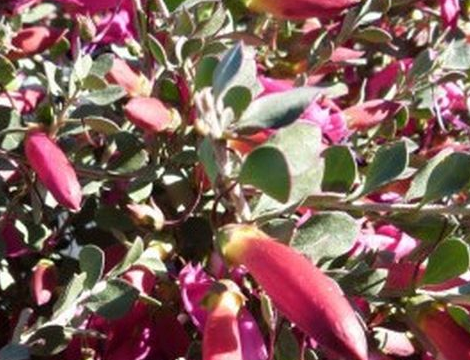The emu bush, which is native to Australia’s semi-arid and dry regions, got its name from an incorrect idea that its fruits were being greedily consumed by the big flightless emu bird. Although this was later proven to be false, the name was kept.
Valentine Emu Bush is a lush evergreen shrub that blooms in late winter and early spring with multitudes of red tubular flowers, blossoming just in time for Valentine’s day. Their tubular-shaped flowers come in a variety of colors, including magenta, yellow, purple, lavender-blue, and pink. A dark mark on the petals can be observed while peeking within the flower.
In cold temperatures, the little oval leaves become scarlet. This shrub requires partial to full sunlight for growth. Valentine Emu Bush can tolerate heat, sun, or drought, it can stay lovely and vigorous in the landscape all year. It grows best when watered regularly, especially in intense heat. Once established, it requires less maintenance.
The height of the valentine emu bush is 3–5 feet and the width ranges from 4 to 6 feet. It has an appealing natural shape but also responds nicely to shearing. Shearing is recommended in the spring, usually during March after the current year’s bloom has concluded, because this will result in a more impressive floral show the next season. It can withstand reflected heat and alkaline soils, but it likes well-drained conditions.
Valentine Bush Size
For desert dwellers who crave bright color in the middle of winter, this rounded, evergreen shrub is a must-have landscape addition. Between January and March, cooler temperatures produce masses of fuchsia to deep red tubular blooms, and the plant’s normally deep green foliage takes on a stunning reddish-purple tint. It is 4 to 5 feet tall and 5 to 8 feet broad on average, which makes it a suitable landscaping plant for small to medium-sized yards.
Valentine Bush Care
Eremophila maculata is the scientific name for the valentine emu bush. The native place of this shrub is Australia. The evergreen emu bush makes a symmetrical mound. It has little green leaves that are spherical. The leaves will turn a reddish hue when the weather cools. Although this shrub is drought resistant, it will require some additional water in the low desert.
In the winter, while the plants are growing and flowering, they can be watered every two to three weeks, and once a month in the summer. Emu bush will become more open and angular if not pruned. This is because the flowers are formed on new, young wood, shearing the plant every year in late spring ensures a more abundant bloom the following fall.
In the winter, a single bush can stand out, but later in the year, when other plants are more prominent, it can fade into oblivion. This hardy, low-maintenance shrub has been given as a gift and will continue to bloom on Valentine’s Day for years to come.
They do not need to be fertilized and are resistant to disease and pests. Emus thrive in wide, sunny areas with alkaline soil and sufficient air circulation. They are most suited to these conditions. The Emu bush, unlike many desert-adapted plants, lacks thorns. As a result, it is well-suited for planting alongside walks and seating spaces.
Emu Bush thrives almost in any well-draining soil, but not in heavy clay soils that are persistently damp. Emu bush thrives in full sun and can withstand a lot of reflected heat. Although drought is resilient, this plant will require some additional water.
Valentine Emu Bush Poison
The spotted emu bush and the Valentine emu bush are two further forms of emu bush. The toxicity of the valentine emu bush is benign. It will become poison if consumed by young children. So, it is advised to keep the children away from the valentine emu bush. Valentine emu bush matures to spectacular deep pink flowers and typically blooms in the spring.
Valentine Emu Bush Zone
The gardeners prefer the following pH levels of soil for the growth of valentine emu bush:
- Slightly Acidic (6.1–6.5)
- Neutral (6.6–7.3)
- Slightly Alkaline (7.4–7.8)
- 7.9–8.4 pH is moderately alkaline.
It does not matter what kind of soil is being used, as long as it drains well. The maximum recommended zone for the bush is zone 11. The minimum cold hardiness ranges from zone 8a -12.2 °C (10 °F) to -9.4 °C (15 °F). This bush is becoming popular among people day by day and is becoming available to homeowners rapidly.



